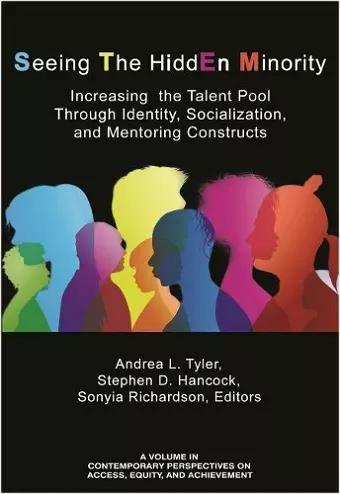Seeing The HiddEn Minority
Increasing the Talent Poolthrough Identity,Socialization, and Mentoring Constructs
Stephen D Hancock editor Andrea L Tyler editor Sonyia Richardson editor
Format:Hardback
Publisher:Information Age Publishing
Published:3rd Jun '20
Currently unavailable, and unfortunately no date known when it will be back

The participation of Black students in science, technology, engineering, and mathematics (STEM) fields, is an issue of national concern. Educators and policymakers are seeking to promote STEM studies and eventual degree attainment, especially those from underrepresented groups, including Black students, women, economically disadvantaged, and students with disabilities. Literature shows that this has been of great interest to researchers, policymakers, and institutions for several years (Nettles & Millet, 2006; Council of Graduate School (CGS), 2009; National Science Foundation (NSF), 2006), therefore an extensive understanding of access, attrition, and degree completion for Black students in STEM is needed. According to Hussar and Bailey (2014), the Black and Latino postsecondary enrollment rates will increase by approximately 25% between 2011 and 2022. It is critical that this projected enrollment increase translates into an increase in Black student STEM enrollment, persistence and consequently STEM workforce. In view of the shifting demographic landscape, addressing access, equity and achievement for Black students in STEM is essential. Institutions, whether they are secondary or postsecondary, all have unique formal and informal academic structures that students must learn to navigate in order to become academically and socially acclimated to the institution (Tyler, Brothers, & Haynes, 2014). Therefore positive experience with the academic environment becomes critical to the success of a student persisting and graduating.
Understanding and addressing the challenges faced by Black students in STEM begins with understanding the complexities they face at all levels of education. A sense of urgency is now needed to explore these complexities and how they impact students at all educational levels. This book will explore hidden figures and concerns of social connectedness, mentoring practices, and identity constructs that uncover unnoticed talent pools and encourage STEM matriculation among Black STEM students’ in preK-12 and post-secondary landscapes. Section 1-Socialization Social discourse concerning how male and females are supposed to enact their socially sanctioned roles is being played out daily in educational institutions. Individuals who chose STEM education and STEM careers are constantly battling this social discourse. It is necessary for P-20 STEM spaces to examine and integrate understanding of socialization within the larger societal culture for systemic and lasting change to happen. Section 2-Mentoring A nurturing process in which a more skilled or more experienced person, serving as a...
ISBN: 9781641139496
Dimensions: unknown
Weight: 333g
144 pages